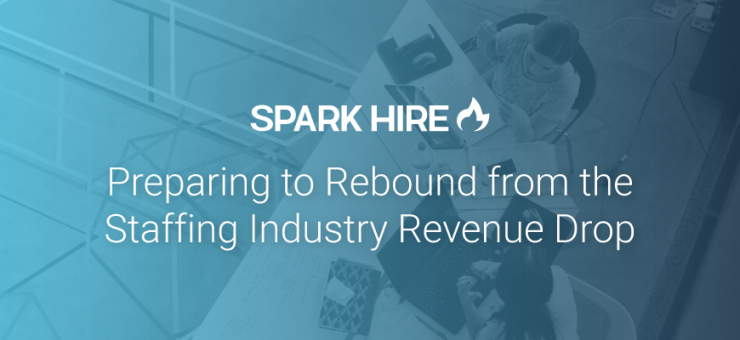The year 2020 has come to a close, and if we’ve learned one thing about the COVID-19 pandemic, it’s that it will have lasting impacts. The staffing industry, for example, is predicted to follow a V-shape revenue pattern in the years to come.
In 2019, the global staffing industry revenue amounted to 497 billion U.S. dollars. At the end of 2020, it’s expected to decelerate to 427 billion U.S. dollars due to the coronavirus outbreak, according to Statista.
In their chart below, you can see the sharp drop in revenue that came in 2020. The expected V-shape comes into play in the following years, when experts anticipate revenue increasing again after the pandemic and recession.

It is critical to keep an eye on these trends in order to plan ahead for the future. Staffing professionals must enter 2021 stronger. As companies rebound out of the recession, here are some tips for how you can prepare your team to take on the challenge of filling roles in the new year:
Conduct market research
The best place to start your rebound strategy is with research. Identify the most in-demand staffing industry needs as soon as possible so you can focus your efforts on the right clients in the new year.
For example, the American Staffing Association noted staffing jobs reached a 10-month high in November 2020. This means the staffing industry is already rebounding. According to their report, the index reached a value of 88 for the first time since January.
Despite the increase in demand, staffing employment was still down 9% from the same week last year, which means there’s still a ways to go before returning to normal. That being said, nearly half (48%) of staffing companies reported gains in new assignments week-to-week.
Additionally, according to the U.S. Bureau of Labor Statistics, November 2020 saw notable job gains in transportation and warehousing, professional and business services, and health care. Employment declined in government and retail trade.
While these changes are not specific to the staffing industry, they’re a good indicator of where to focus your efforts more specifically (and what industries to avoid when acquiring new clients). You can also use these details to gauge where to source available talent.
For instance, while it might not be favorable to be staffing for government and retail trade jobs at this moment, there are likely job seekers in those fields who are seeking employment. Proactively reach out to talent with skills that are transferable to your target industry.
When conducting your market research, stay up-to-date with the latest news releases from the American Staffing Association and the U.S. Bureau of Labor Statistics. Also, consider tapping into some other reputable resources. For example:
- Pew Research Center has a Work and Employment section on its website.
- eMarketer offers insights into a number of industries.
- Gartner TalentNeuron uses 65,000 global talent data sources to compile market metrics.
- LinkedIn Talent Insights uses their network data to provide market intelligence.
Identify which of these sources work best for your team as you prepare your rebound strategy. Refer back to them throughout the year as you continue to adjust your strategies and work with new clients.
For your existing clients, take a look at their competitors as well. Look at hiring volumes and job descriptions to see how they changed over the course of 2020 and are preparing for the new year.
Take a client pulse-check
Once you’ve conducted external research, it’s also essential to solicit feedback from current clients on what they feel did or did not work in 2020. The past year brought forth dozens of workplace changes, so you need to identify your strengths to continue supporting clients virtually.
Find out if your clients were satisfied with your support in 2020 with a survey. You can start by asking them to rate their satisfaction on a scale from 1 to 10; be sure to offer a section where they can write a few sentences about why they chose that ranking. Additionally, you can ask them the following questions:
- How can we improve your experience?
- What’s working for you, and why?
- What can our team do better?
- Do you have any additional comments or feedback for us?
Aside from what you did well, get a pulse-check on what changed within their company this year. Their culture likely shifted internally, and your team must articulate that change to staffing candidates. Ask your clients:
- How do you foster your company culture in a virtual work environment?
- What employee benefits does your team most value in a remote setting?
- Do you plan to maintain a remote or partially remote workforce beyond the pandemic?
- What changes are more short-term and won’t continue after the pandemic?
- What workflows do you anticipate keeping as part of your long-term company norms?
As you recruit for your clients’ staffing needs, be transparent about all of these updates with each candidate. They need to understand what the company they’re entering looks like now, rather than the same highlights you focused on a year ago.
Update strategies
Building upon your market and client research, your team should now be able to update your 2021 strategies.
Start with key performance indicators (KPIs). Looking at the new company culture, modified hiring volumes, and staffing industry insights, are you still measuring success the right way? The chances are good you need to change your goals.
For example, you might aim for more candidates in a specific category rather than overall application volume. You might also prioritize diverse talent slates rather than time-to-fill. Whatever changes you make, it’s essential to identify them right away to create a new strategy that helps you reach your new goals.
Once you’ve identified your goal, you must next change the way you pitch to new clients. It’s easy to get caught up in using the same old presentation you’ve had for years. But there are too many recent unknowns in the staffing industry to avoid change. Create a strategy that prioritizes remote work culture and your designated KPIs.
If one of your KPIs is to reduce time-to-fill or cost per hire, you might invest in an interview scheduler or options for one-way video screenings. These tools will cost you upfront but save you time and money in the long run as a staffing team.
Within your team, solidify the right communication and collaboration tools to help you work together and with clients more effectively. These might include everything from scheduling software and interview platforms to project management and client messaging tools.
Remember: In a year of uncertainty, it is critical to pay attention to current client feedback. Use what you learn to make the necessary changes to your strategies and increase overall effectiveness.
Strengthen client relationships
After you’ve won your clients over with your new strategy, you’re still not done. You also need to develop a client-onboarding system that maximizes your working relationship together.
While client-onboarding has always been a useful step to take, it is even more critical with remote work. Ensure they are set up with tools their team can access to communicate and collaborate with yours.
During this process, you should also establish clear expectations regarding the work itself. Make sure your new and old clients understand the current climate. You might start the conversation with a template similar to this:
Our way of working on our staffing team has shifted during the course of the pandemic. In full transparency, we did have to scale back on the number of people supporting each project, which may impact the amount of time it takes to fill your roles.
We’ve implemented a number of new processes to counteract the smaller team. For example, while you might be used to us conducting interviews as phone screens, we have switched to one-way video interviews to become more efficient with the increased demand for jobs.
Additionally, we implemented XXXX tool to help stay better connected with you throughout the hiring process. Even though we’ve worked together in the past, we’d like to take you through our updated client onboarding process to make this transition as seamless as possible for you.
You should also be honest with employers about how the economic impacts of 2020 influenced the talent pool. For example, if your client is in the transportation or warehousing industries, you can share you’ll be competing with more companies due to their recent job gains. You might say
We’re excited to help you achieve your staffing goals this quarter! Knowing you need to hire X warehouse workers by March, we did some preliminary research to understand the current landscape for this talent.
We’ve seen heightened demand for this workforce in recent months. Employment rose by 37,000 in warehousing and storage in November, according to the Bureau of Labor Statistics. But we also know staffing employment is still down 9% from last year due to the pandemic. We’re hoping this means there will be plenty of warehouse staffing talent to meet your needs.
However, if your client works in retail trade, there are fewer jobs in the market and candidates will be more in supply. You might say:
We’re excited to help you achieve your staffing goals this quarter! Knowing you need to hire X retail workers by March, we did some preliminary research to understand the current landscape for this talent.
We’ve seen a decrease in jobs for this workforce in recent months. Knowing staffing employment is still down 9% from last year due to the pandemic, we’re hoping to fill your needs quickly, given the low demand for this talent.
Whatever changes you face, whether internal or external, being open with your clients about expectations can strengthen your relationships as you move forward into 2021.












